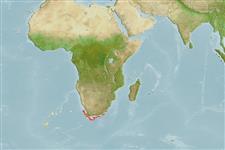Elasmobranchii (sharks and rays) >
Carcharhiniformes (Ground sharks) >
Pentanchidae (Deepwater catsharks)
Etymology: Apristurus: a-, Latin privative, i.e., without; pristis, from pristes (Gr.), sawyer (but here meaning saw); oura (Gr.), tail, referring to absence of saw-toothed crest of enlarged dermal denticles along upper edge of caudal fin as found in the closely related Pristiurus (=Galeus) (See ETYFish); saldanha: Named for Saldanha Bay, South Africa, type locality (See ETYFish).
More on author: Barnard.
Environment: milieu / climate zone / depth range / distribution range
Ecology
Marine; bathydemersal; depth range 453 - 717 m (Ref. 5578). Deep-water; 31°S - 40°S
Southeast Atlantic: Cape Columbine to south of False Bay in South Africa (Ref. 5578).
Size / Weight / Age
Maturity: Lm ? range ? - ? cm
Max length : 88.0 cm TL male/unsexed; (Ref. 5578)
Short description
Identification keys | Morphology | Morphometrics
Dorsal spines (total): 0; Anal spines: 0. A stout, plain catshark with moderately large eyes, a long, thick and broad snout, and long labial furrows; mouth not projecting in front of eyes; pectoral fins large (Ref. 5578). Uniformly dark grey-brown (Ref. 5578).
Body shape (shape guide): elongated.
Found on the continental slope (Ref. 244). Feeds on small bony fish and cephalopods (Ref. 5578). Oviparous (Ref. 50449).
Life cycle and mating behavior
Maturity | Reproduction | Spawning | Eggs | Fecundity | Larvae
Oviparous (Ref. 5578). Paired eggs are laid. Embryos feed solely on yolk (Ref. 50449).
Compagno, L.J.V., 1984. FAO Species Catalogue. Vol. 4. Sharks of the world. An annotated and illustrated catalogue of shark species known to date. Part 2 - Carcharhiniformes. FAO Fish. Synop. 125(4/2):251-655. Rome: FAO. (Ref. 244)
IUCN Red List Status (Ref. 130435: Version 2025-1)
Threat to humans
Harmless
Human uses
Fisheries: of no interest
Tools
Special reports
Download XML
Internet sources
Estimates based on models
Preferred temperature (Ref.
123201): 6.2 - 11.9, mean 10.8 °C (based on 5 cells).
Phylogenetic diversity index (Ref.
82804): PD
50 = 0.5000 [Uniqueness, from 0.5 = low to 2.0 = high].
Bayesian length-weight: a=0.00355 (0.00175 - 0.00721), b=3.08 (2.90 - 3.26), in cm total length, based on LWR estimates for this (Sub)family-body shape (Ref.
93245).
Trophic level (Ref.
69278): 4.2 ±0.7 se; based on diet studies.
Resilience (Ref.
120179): Very Low, minimum population doubling time more than 14 years (Fec assumed to be <10).
Fishing Vulnerability (Ref.
59153): High vulnerability (55 of 100).
🛈
